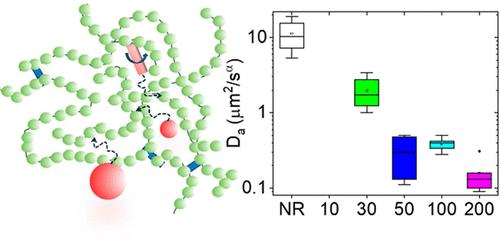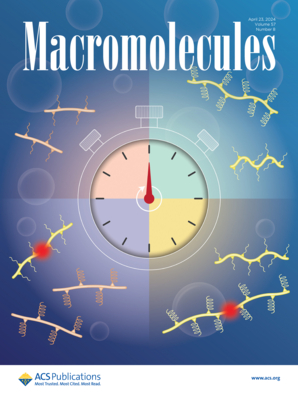Nanorheology of a Reconstituted Mucin Gel
IF 5.1
1区 化学
Q1 POLYMER SCIENCE
引用次数: 0
Abstract
I present results of diffusion nanospheres with a wide range of sizes (d) from 30 to 200 nm and nanorods of aspect ratio (≈3.5) within a model synthetic mucin gel possessing physiological and viscoelastic properties similar to lung mucus. The technique of two-photon fluorescence correlation spectroscopy was used, which provides high temporal resolution so that rotational dynamics of anisotropic particles occurring faster than milliseconds time scale can also be interrogated. The particle sizes in these experiments are smaller compared to mesh size (ax) in the gel, and thus, their motion is sensitive to nanoscale heterogeneity, segmental dynamics, and interstitial fluid properties. The particles of sizes 100 and 200 nm exhibited anomalous subdiffusion with an exponent ≈0.5, which is a manifestation of coupling of particle motion with local Rouse dynamics. The smaller spheres (30 and 50 nm) experience near normal diffusion but experience an effective viscosity that is proportional to the area of the particles. It can be explained by the presence of unreacted mucin within pores, which forms a semidilute solution with the associated correlation length, ξ < d. For nanorods of size 10 nm (d) × 38 nm (L), the rotational diffusion is slowed down more significantly compared to translational diffusion. The analysis indicated that translation is dominated by motion along the long axis of the rod when d < ξ, while the reduction of rotational motion is comparable to the slowdown of spheres with size equivalent to the length of the rod (L > ξ). The estimation of the first passage time distribution function for a model mucus layer of thickness 50 μm showed that subdiffusion can strongly affect the large length-scale transport of NPs.

重组粘蛋白凝胶的纳米流变学研究
我展示了扩散纳米球的结果,其尺寸范围从30到200纳米不等(d),纳米棒的纵横比(≈3.5)在模型合成粘蛋白凝胶中具有类似于肺粘液的生理和粘弹性特性。采用双光子荧光相关光谱技术,该技术提供了高时间分辨率,使得各向异性粒子在毫秒时间尺度内发生的旋转动力学也可以被询问。这些实验中的颗粒尺寸比凝胶中的网格尺寸(ax)要小,因此,它们的运动对纳米尺度的非均质性、节段动力学和间隙流体特性很敏感。粒径为100 nm和200 nm的粒子表现出反常的亚扩散,其指数≈0.5,这是粒子运动与局部劳斯动力学耦合的表现。较小的球体(30和50纳米)的扩散接近正常,但其有效粘度与颗粒的面积成正比。这可以用孔隙中存在未反应的粘蛋白来解释,这些粘蛋白形成半稀溶液,相关长度为ξ <;d.对于尺寸为10 nm (d) × 38 nm (L)的纳米棒,旋转扩散速度比平移扩散速度慢得多。分析表明,当d <;ξ,而旋转运动的减速相当于大小相当于杆长度的球体的减速(L >;ξ)。对厚度为50 μm的模型黏液层的第一次通过时间分布函数的估计表明,亚扩散对NPs的大尺度迁移有强烈的影响。
本文章由计算机程序翻译,如有差异,请以英文原文为准。
求助全文
约1分钟内获得全文
求助全文
来源期刊

Macromolecules
工程技术-高分子科学
CiteScore
9.30
自引率
16.40%
发文量
942
审稿时长
2 months
期刊介绍:
Macromolecules publishes original, fundamental, and impactful research on all aspects of polymer science. Topics of interest include synthesis (e.g., controlled polymerizations, polymerization catalysis, post polymerization modification, new monomer structures and polymer architectures, and polymerization mechanisms/kinetics analysis); phase behavior, thermodynamics, dynamic, and ordering/disordering phenomena (e.g., self-assembly, gelation, crystallization, solution/melt/solid-state characteristics); structure and properties (e.g., mechanical and rheological properties, surface/interfacial characteristics, electronic and transport properties); new state of the art characterization (e.g., spectroscopy, scattering, microscopy, rheology), simulation (e.g., Monte Carlo, molecular dynamics, multi-scale/coarse-grained modeling), and theoretical methods. Renewable/sustainable polymers, polymer networks, responsive polymers, electro-, magneto- and opto-active macromolecules, inorganic polymers, charge-transporting polymers (ion-containing, semiconducting, and conducting), nanostructured polymers, and polymer composites are also of interest. Typical papers published in Macromolecules showcase important and innovative concepts, experimental methods/observations, and theoretical/computational approaches that demonstrate a fundamental advance in the understanding of polymers.
 求助内容:
求助内容: 应助结果提醒方式:
应助结果提醒方式:


